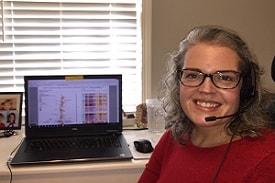Flu Fighter: Rebecca Kondor
Meet Rebecca Kondor, PhD, the lead of the Genomic Analysis Team of the Virology, Surveillance and Diagnosis Branch (VSDB) in the Influenza Division within CDC’s National Center for Immunization and Respiratory Diseases (NCIRD).
Since joining CDC in 2004, Dr. Kondor has focused her efforts on expanding informatics and bioinformatics infrastructure and improving genomic analysis pipelines. Bioinformatics involves developing methods and software tools to analyze and interpret biological data. Dr. Kondor builds laboratory surveillance capacity for the analysis of circulating flu viruses to look at how they are changing over time as well as how similar they are to other flu viruses, including the candidate vaccine viruses (CVVs) used by flu vaccine manufacturers to create seasonal flu vaccines. When circulating flu viruses undergo antigenic changes, this can mean that the CVVs used in the composition of seasonal flu vaccines need to be updated. Dr. Kondor’s work generates some of the data used by the World Health Organization (WHO) and the U.S. Food and Drug Administration (FDA) to decide which flu viruses should be included the composition of seasonal flu vaccines.
Dr. Kondor’s team also actively participates in building laboratory sequence analysis capabilities worldwide by offering training and technical expertise, providing reference materials, and additional support. She has established productive collaborations with partners within CDC as well as in academia, industry, and other governmental agencies.
Name: Rebecca Kondor, PhD
Title: The lead of the Genomic Analysis Team within the Influenza Division’s Virology, Surveillance and Diagnosis Branch, the Deputy Director of the WHO Collaborating Center for Surveillance, Epidemiology and Control of Influenza at CDC, a technical advisor for the WHO Global Influenza Surveillance and Response System
Location: Georgia
- What role do you play in fighting flu?
My team performs genomic surveillance of influenza viruses which cause yearly epidemics. We study the genetic properties of flu viruses and track where they are circulating. We also study how the changes in the genetic properties of the virus can affect the ability of antibodies to recognize new changes on the surface proteins of the virus. This information helps us know when flu vaccines need to be updated to offer the best protection against the most recent flu viruses. My team also works closely with the other teams in the branch to identify which flu viruses should be used to create candidate vaccine viruses (CVVs). Seasonal flu vaccines are designed to protect against the flu viruses that research indicates are most likely to spread and cause illness among people during the upcoming flu season. Our work provides vital data that is presented at the WHO vaccine composition consultations that occur twice a year. At the conclusion of these meetings, recommendations are made for which viruses to include in the composition of Northern and Southern Hemisphere flu vaccines. These meetings take place in February for selection of the upcoming Northern Hemisphere’s seasonal flu vaccines and in September for the Southern Hemisphere’s flu vaccines. During the 2009 H1N1 Pandemic, I was part of the group that identified the genomic make-up of the A(H1N1)pdm09 virus responsible for the pandemic. We showed that the pandemic virus was genetically related to viruses spreading in pigs. It’s important to remember that there are other influenza viruses spreading in animals which could someday gain the ability to infect people. Flu pandemics occur rarely, but they can happen when flu viruses from animals gain the ability to infect people easily and spread from person to person in an efficient and sustained way. - What is the most rewarding part of your work?
CDC’s Influenza Division is a member of the WHO’s Global Influenza Surveillance and Response System (GISRS), and I serve as the deputy director of the WHO Collaborating Center for Surveillance, Epidemiology and Control of Influenza. As part of this system, I have enjoyed meeting and training a global flu fighter network on influenza virus genetic analysis. Being able to strengthen both the national and international genetic analysis capabilities has been the most rewarding part of my work. - What is the most difficult part of your work?
The most difficult part of my work is the tight turnaround time for the data analysis packages for the vaccine recommendation consultations. Due to the time it takes to manufacture influenza vaccines, the meeting to recommend the vaccine for the following season occurs right at the peak of the current season. Our group has worked to decrease the turnaround time for virus characterization by increasing the amount of genetic sequencing so that there is more information available for recent viruses. My team also has expanded the methods we use to analyze the data to add additional types of information to improve the vaccine selection process. - How serious is flu? What should people know about the risk of flu?
An influenza virus infection can lead to serious illness and complications regardless of your age or health status. But risk of serious illness can be especially high in the very young (children younger than 5 years old, and especially those younger than 2 years), people 65 years of age and older, those with immune compromising conditions, and pregnant people. While flu viruses can circulate year-round, most flu activity in the United States occurs during the flu season, which typically lasts from October to May. However, other countries have different flu seasons, requiring year-round global surveillance. - What would you say to those who are hesitant about getting a flu vaccine?
While there are antiviral treatments which can lessen the duration of illness, the best way to decrease risk of serious flu illness is getting your annual flu shot.


